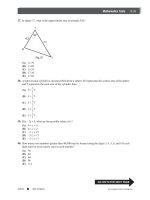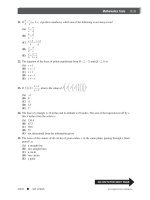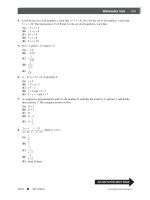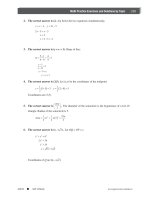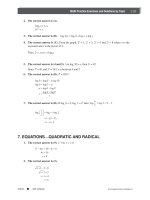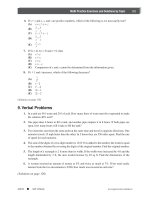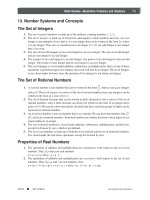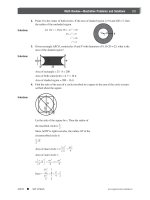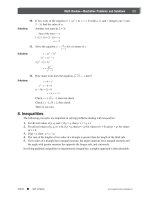SAT II Biology Episode 1 Part 8 pdf
Bạn đang xem bản rút gọn của tài liệu. Xem và tải ngay bản đầy đủ của tài liệu tại đây (324.6 KB, 20 trang )
9. In the illustration below, the strand with an (*) is the
(A) promoter.
(B) Okasaki fragment.
(C) template.
(D) lagging strand.
(E) leading strand.
10. Darwin’s Natural Selection includes all of the following EXCEPT
(A) Variation can be due to mutations.
(B) The difference in survivability between organisms may be
due to variation.
(C) Not all organisms may survive, due to competition.
(D) Organisms produce more offspring than can survive.
(E) Some organisms will be more fit to survive than others.
EXPLANATION OF ANSWERS FOR MULTIPLE-CHOICE QUESTIONS
1. The correct answer is (B). In RNA, thymine is replaced by
uracil, so the correct choice is (B), where DNA adenine is said to
bond to an RNA thymine. All the other choices are incorrect,
including the DNA guanine to an RNA cytosine. The testmaker
may depend on the student vaguely remembering that a certain
base-pairing between DNA and RNA is not possible and may
choose choice (C) as being correct. This is not the case.
2. The correct answer is (E). Guanine is not replaced in RNA. It
is found in both DNA and RNA. The trick here, once again, is the
vague recollection of something being replaced. Of course,
thymine in DNA is replaced by uracil in RNA, and uracil is on the
list. However, the question here asks about the replacement of
guanine, which does not occur. The bases listed in choices (A)
and (C) also are found in RNA.
MOLECULAR GENETICS—DNA AND EVOLUTION
137
Peterson’s n SAT II
Success: Biology E/M www.petersons.com
3. The correct answer is (C). These recent conclusions about
mutations—recall that Darwin did not know of mutations—are all
the reverse of those listed in the choices, with the exception of
choice (C), the correct answer. Rates, in fact, tend to be below
in populations, mutations are generally not lethal, any gene
location can be affected, and they are felt to be the source of
genetic variation. Darwin felt over-production of offspring was
the source of potential variation.
4. The correct answer is (A). The complimentary strand for the
indicated DNA strand would begin at the 38 end, not at the 58
end. In addition, it would also have thymine—T. Finally, opposite
A would be T, and vice-versa, and opposite G would be C, also
vice-versa.
5. The correct answer is (B). Choices (A), (C), and (E) are all
places on the DNA that are constant and form the sides of the
DNA “ladder.” The place at which the molecule differs is in the
bases that form the rungs of this ladder, providing DNA with a
virtually infinite number of variations. Ribose, of course, refers to
RNA and should not be on the list when discussing DNA.
6. The correct answer is (B). tRNA, which contains 3 anti-codon
bases for every amino acid it carries, matches up opposite the
mRNA codons that are also three bases long. This means that the
mRNA in question potentially codes for 429/3 amino acids. This
gives us a potential of 143 amino acids or choice (A). However,
the stop sequence does not code for an amino acid, so this gives
us 142 amino acids coded for. Care should be exercised when
considering the start sequence. While not a part of the resulting
protein, that site does code for the amino acid methionine in the
translation process.
7. The correct answer is (B). The foundation of Griffith’s work
was that the mice that received the killed Smooth-coat strain/
Rough-coat strain mix, in fact, died. This suggested that the
inheritable trait of producing a lethal substance to mice could be
inherited by the R-strain bacteria. All the other choices are true
and led to the experiment outline briefly in choice (B), but the
conclusion of that experiment, once again, was that all the mice
died.
8. The correct answer is (A). In DNA replication, each new
strand receives half of the original DNA, a process said to be
semi-conservative—it conserves only half of the original DNA for
each new strand produced. Crossing over and non-disjunction are
macro-genetic events that occur during meiosis and pass on all of
the genetic information for the event. Crossing over exchanges
whole parts—however long—of one chromosome with whole
CHAPTER 5
138
Peterson’s n SAT II
Success: Biology E/Mwww.petersons.com
parts of a homologous chromosome. Non-disjunction causes an
entire chromosome to be incorrectly separated. Translation and
transcription pass along the entire code for a protein from RNA
to polypeptide and DNA to RNA, respectively.
9. The correct answer is (E). The strand with a (*) is being
replicated from the 58 end onward and will proceed without
delay. The strand with the 38 end as a start—opposite the 58 end
on its compliment, the sense strand—makes this strand the
anti-sense strand and is fashioned piece by piece from Okasaki
fragments. These fragments are bonded onto the anti-sense strand
with DNA ligases. The construction of the 38 strand then
proceeds slower than the construction of the 58 end and is said
to lag behind. Since the strand with a (*) is the 58 end, it is not
an Okasaki fragment, nor is it a template; the sense strand is the
template and a promoter is a molecule that starts the process: it
is not a DNA molecule, but a protein.
10. The correct answer is (A). Darwin did not know of mutations,
so choice (A) is the correct answer. Fundamental to his idea of
natural selection was that, in order, (1) organisms produce more
offspring than can survive and, (2) due to competition, not all
organisms will survive, which means, (3) some organisms will be
more fit to survive than others, and (4) variation may be the
reason for the difference in survivability.
MOLECULAR GENETICS—DNA AND EVOLUTION
139
Peterson’s n SAT II
Success: Biology E/M www.petersons.com
VOCABULARY
adenine
anticodon
base pairing
base substitutions
codons
complementary
cytosine
deletions
deoxyribonucleic acid (DNA)
deoxyribose
DNA polymerase
DNA replication
double helix
Down’s syndrome
duplication
exons
guanine
hydrogen bonds
insertions
introns
inversion
mRNA
mutation
nitrogenous base
nondisjunction
nucelotides
peptide bond
point mutation
promoters
proteins
protein synthesis
ribonucleic acid (RNA)
ribose
RNA polymerase
RNA primer
rRNA
template
thymine
transcription
translation
translocation
tRNA
uracil
CHAPTER 5
140
Peterson’s n SAT II
Success: Biology E/Mwww.petersons.com
Unit III—Organizations
and Populations
Chapter 6
ORGANISMS AND POPULATIONS
OVERVIEW
This material constitutes about 30 percent of the SAT II Biology
exam. This part of the study of biology, then, contains the bulk of the
material on the scale of entire organisms. Previous chapters have
dealt basically with how the organisms function mostly at the
molecular level. We now explore organism-level structure—and,
therefore, function—and on a grander scale, the biology of the
organism and how organisms as populations interact with one
another and with other organisms, as well as with their environment.
Carolus Linnaeus is credited with organizing living things into
understandable groups based on their structures and giving them a
two-part name. Today, we use many characteristics, including
behavior and, more recently, DNA analysis. Since the earliest times,
humans have attempted to understand their world, and one of the
ways to start the process is to organize it. The way humans have
done this has changed over time. This chapter is about the grouping
of organisms. Some of the vocabulary at the end of the chapter will
not be detailed here, but we suggest that the student know all of
those terms; this holds true for all the chapters in this book.
CLASSIFICATION
Taxonomy, or the science of classifying organisms, groups organisms
into categories based on various characteristics.
SCHEMA
Just as we find in grocery stores, the organisms are placed in specific
categories. Imagine trying to find an item in the store if all of the
delivery vehicles dumped their goods at the front door. In a like
manner, grouping organisms has many benefits. Imagine proposing
that a predator of a parasite be introduced into the local environment
in an attempt to control the parasite population, but instead, the
organism you believe to be the predator is actually a slight variation
of that predator and has no interest whatsoever in the parasite you
are trying to eliminate. You may now have two problems to deal
with, and at the very least, you haven’t done anything to help control
the parasite.
143
Peterson’s n SAT II
Success: Biology E/M www.petersons.com
Aristotle
Aristotle’s classification system proposed that if something moves, it
is an animal, and if it doesn’t, it is a plant. Of course, sponges were
mistakenly taken for plants, and when they threatened the shellfish
industry centuries ago, were “killed” by being cut up and tossed back
into the sea. To the surprise of the shellfish harvesters, the next year,
the number of sponges had increased; the shellfishers were actually
helping the sponges reproduce (asexually) by their actions.
Linnaeus
Linnaeus proposed naming organisms by a two-name system that we
call binomial nomenclature. These were very specific names based
on the organism’s characteristics and are the genus and species of
today. Note that the genus is always capitalized and the species is
not, as in Terrestris americanus, and the entire name is underlined or
italicized.
Modern
The modern system of classification now contains five major groups
called kingdoms. Life on the planet could be seen as analogous to a
grocery store. The major consumer item areas, such as produce,
dairy, and canned goods, would be analogous to the kingdoms of
living things. As with the grocery store, the sub-categories get more
and more specific until it is possible to name an item exclusive of all
other items in the store. You should know the categories, starting
with the largest (the kingdom) and continuing to narrower and
narrower groups in the sequence: Kingdom, Phylum, Class, Order,
Family, Genus, and Species. In plants, the word “phylum” is replaced
with the word “division.” Modern day study has become so detailed
that we will now find such categories as sub-genus and super-species.
The student is responsible only for the above schema. Most beginning
biology students become familiar with the mnemonic—memory
device—in a variety of expressions, one being King Phillip Come Out
For Goodness Sakes. The first letter of each word, in the order given,
is the first letter of each of the major categories in taxonomy.
CHAPTER 6
144
Peterson’s n SAT II
Success: Biology E/Mwww.petersons.com
EXAMPLES OF GENUS AND SPECIES
Canis familiarus
domesticated dog
Felis feline
domesticated cats
Homo sapiens
modern humans
MODERN
TAXONOMY
Today, scientists generally agree on five major categories of living
things, or kingdoms, although there are several classification systems.
Students may want to become familiar with how these categories
came to be agreed upon. You should recall that some of these
organisms were mentioned in other chapters and at other levels. The
good news is that the SAT II Biology exam does not test for informa-
tion as detailed as how the phylogenic categories arose. A brief word
about viruses seems appropriate at the beginning of a discussion on
the taxonomy of living things. Viruses, while not considered a living
thing, can, nonetheless, take over the cell chemistry of a living thing
to reproduce. We will now outline the schema of living things.
PROKARYOTE (MONERAN)
Prokaryotes are single-celled, microscopic prokaryotic (see Chapter 2)
cells with no distinct nucleus or other membrane-enclosed organelles.
ORGANISMS AND POPULATIONS
145
Peterson’s n SAT II
Success: Biology E/M www.petersons.com
Bacteria
Bacteria have cell walls composed of peptidoglycan, an amino
acid–sugar complex, and circular DNA. Composition of the cell wall
provides us with the Gram staining means of identifying certain types
of bacteria. Reproduction of bacteria was outlined in an earlier
chapter. Some bacteria possess flagella. While many bacteria are
decomposers, some fix nitrogen and other elements in a form usable
by organisms, and some are pathogenic.
A. Shapes
Bacteria can be found in three shapes: coccus (round-shaped),
bacillus (rod-shaped)—the one the SAT II Biology exam commonly
refers to when asking a question about bacteria—and spirillus
(spiral-shaped).
B. Types
Aerobic (oxygen-needing) bacteria are the largest group of bacteria.
Anaerobic (not needing oxygen) bacteria are found in two groups:
those that need an oxygen-free environment (obligate) and those that
do not need a lack of oxygen, but a small amount of oxygen will not
kill them (facultative).
CHAPTER 6
146
Peterson’s n SAT II
Success: Biology E/Mwww.petersons.com
C. Significance
Bacteria are the most populous organisms on earth—they can be
useful for things like making pickles from cucumbers, or they can be
lethal, as in the case of pneumococcus and several STDs.
Cyanobacteria
Producer prokaryotes, their numbers can “explode” under the right
conditions and are the cause of water pollution associated with algal
blooms. They are photosynthesizers that sometimes fix nitrogen.
They, in symbiotic association with fungi, form lichens.
PROTISTA
Protista (also called protoctist) are single-celled eukaryotes. This
kingdom is a composite for organisms that do not fit in other
kingdoms.
Protozoan
Protozoan are classified by their mode of locomotion. Amoeba and
paramecium are two of the Protists about which test questions are
asked. The amoeba is a heterotrophic, shapeless organism that moves
by pseudopods and engulfs its food by the endocytotic method
known as phagocytosis. The paramecium, also a heterotroph, moves
about using tiny hair-like projections known as cilia. Cilia also help
the paramecium in engulfing food.
Amoeba
ORGANISMS AND POPULATIONS
147
Peterson’s n SAT II
Success: Biology E/M www.petersons.com
Eukaryotic algae
The plant-like protists, they include green algae, brown algae, golden
algae, diatoms, dinoflagellates, red algae, and the euglena. The
euglena, heterotrophic in the absence of light, possess chlorophyll
and from one to three flagella. Green algae, in association with fungi,
also form lichens.
Slime molds
Fungi-like protists that resemble fungi because at one point in their
life cycle they come together as a unit—looking like a multicelled
organism—and form spores.
FUNGI
Formerly classed as plants, fungi do not possess chlorophyll—making
them heterotrophs. The fungi are structurally different from plants, so
they have been placed in their own kingdom. For example, they have
no cell membrane. Some fungi are unicellular, while others are
multicellular. Fungi are predominantly haploid, becoming diploid for
the purpose of reproduction through the production of spores.
Types
Fungi are classed into three groups based on how they obtain
nutrients.
A. Saprophytic
Live off dead organisms
CHAPTER 6
148
Peterson’s n SAT II
Success: Biology E/Mwww.petersons.com
B. Parasites
Live off live organisms
C. Symbiotic
Work in concert with other organisms
Members
The following are the major groups of fungi covered on the SAT II
Biology Exam.
A. Molds (the zygospore fungi)
Molds invade hosts through root-like hyphae, which they also use for
reproduction. Bread molds are an example of this group.
B. Yeast (the sac fungi that for m ascospores)
Along with mildews, they are primarily unicellular but form fruiting
bodies containing ascospores for reproduction. This group also
includes the much sought after truffle.
C. Mushroom (the club fungi that form basidiospores)
Multicellular fungi include the well-known mushroom.
ORGANISMS AND POPULATIONS
149
Peterson’s n SAT II
Success: Biology E/M www.petersons.com
D. Lichens
A symbiotic union between fungi and either a chlorophyta [eukary-
otic algae] or a cyanobacteria.
PLANTS
Multicellular and autotrophs, these organisms contain chlorophyll
bound in organelles called chloroplasts—chlorophyll plastids.
The dominant generation in most plants is diploid, most have
vascular tissue, and they reduce desiccation with a cuticle—a waxy
coating on all aerial parts. Advanced forms possess ovaries and have
adapted to seasonal changes, as in the case of the deciduous trees.
You will want to use this outline as a guide to studying plants. We
start with bryophytes despite the fact that the nonvascular bryophytes
are very different from the vascular plants.
Bryophytes
The simplest plants, these plants do not have true roots, stems, or
leaves. This fact limits the movement of water through the organisms
and therefore is a major limitation to the plants, mostly in size, but
also in storage of water and in the process of reproduction, so their
habitat is very moist. In reproduction, for example, the sperm must
swim to the egg. Adult bryophytes are haploid, entering the diploid
CHAPTER 6
150
Peterson’s n SAT II
Success: Biology E/Mwww.petersons.com
stage when the sperm fertilizes the egg. Following this, spores are
produced by meiosis and alternation of generation has once again
brought about the haploid generation, which dominates the cycle.
This division of plants includes the mosses, liverworts, and horn-
worts.
Vascular plants
More typical of the plants are the vascular members of the kingdom,
some of which are extinct but are included in the schema. Vascular
plants are predominantly diploid throughout their life cycle, produc-
ing haploid sperm and egg for the purposes of reproduction. Eggs are
produced in an ovary and sperm in the pollen grains.
A. Seedless vascular plants
1. Lycophytes—one group of lycophytes includes the extinct woody
trees of the carboniferous period, and the second includes
epiphytic plants that live off other plants, such as the so-called
club mosses because of their club-shaped, spore-producing
cones.
2. Sphenophytes—includes another group of extinct trees from the
carboniferous period and herbaceous plants known as horsetails
because they produce filamentous leaves that resemble horsetails.
3. Pterophytes—this group includes the ferns and has spore-bearing
capsules on the underside of the leaves, called sori.
4. Gymnosperms—the first group of seed plants, some “naked
seed” conifers take up to three years to complete reproduction,
with the result being an unprotected seed. Gymnosperms bear
pollen-producing male cones and ovule-bearing female cones all
on the same tree.
5. Angiosperms—include the flowering plants, a major evolutionary
adaptation for the angiosperms, and produce coated or covered
seeds within an ovary on the flower.
ORGANISMS AND POPULATIONS
151
Peterson’s n SAT II
Success: Biology E/M www.petersons.com
6. Classification
• Monocots—In seeded plants, the structure that stores the
next generation’s embryo, as well as a good amount of
nutrients to get the embryo started, is contained in
cotyledons. These are not seed halves, although the dicots
contain two. Monocots only contain one.
• Dicots—so-called because they have two seed-bearing
structures.
7. Tissues—there are three different types of plant tissues based on
their function.
• Ground tissue—these tissues serve as support tissues for
storage, photosynthesis, and secretion. Examples are
collenchyme, sclerenchyme, and parenchyme tissues.
• Dermal—covers the outer portion of plants and includes
the guard cells, hair cells, stinging cells, and glandular
tissue. The aerial tissues secrete the cuticle, a waxy
coating that acts to prevent water loss.
• Vascular—for transporting material throughout the plant,
which includes xylem and phloem. These tissues, respec-
tively, carry water and minerals up the plant and distrib-
ute photosynthetic products throughout the plant. Xylem
cells are perforated specialized cells producing, in effect,
one long tube. These tissues play a vital role in the
transpiration-tension theory that explains how through
adhesive and cohesive forces—hydrogen bonding, surface
tension, capillary action—and the loss of water through
the stomata, a plant moves water, in some cases, over
considerable distances. Phloem tissue is made up of
sieve-tube cells and companion cells and is likewise
“connected,” helping to pass on nutrients.
8. Organs—vegetative organs are roots, stems, and leaves. Repro-
ductive organs are flowers, fruits, and seeds.
• Seeds—contain the next generation’s embryo as well as
stored nutrients. Under the right conditions and with the
absorption of water, the seed germinates. The seed then
CHAPTER 6
152
Peterson’s n SAT II
Success: Biology E/Mwww.petersons.com
goes through a primary and a secondary growth on the
way to maturing into the next generation of adult plant.
• Leaves—leaves are the main photosynthetic structure in
plants and contain five distinct parts, each with their own
function.
x Epidermis—the outer layer of cells, like the skin of
an animal, it serves to protect and prevent desicca-
tion. A waxy substance called a cuticle may be
secreted.
x Palisades layer—so-called because it contains a
layer of closely packed vertical photosynthetic cells.
The arrangement allows the maximum exposure to
the light of the sun. The cells are photosynthetic.
x Spongy layer—contains photosynthetic cells more
loosely connected than those in the palisade layer.
The spaces provide room for CO
2
,O
2
, and H
2
O
vapor to circulate.
x Guard cells—found on the exterior side of leaves,
these are specialized epidermal cells that change
shape as the amount of water in the leaf changes.
The opening that results when they swell up with
water is called the stomate. It provides for passage
of gases in and out of the leaf, including water
vapor.
x Vascular bundles—made up primarily of xylem and
phloem tissues bundled together.
• Stems—the main support of the plant, they also contain
tissues for storage of materials as well as vascular tissue
and, in some cases, cells with chloroplasts.
ORGANISMS AND POPULATIONS
153
Peterson’s n SAT II
Success: Biology E/M www.petersons.com
• Roots—are the extensions of the stem, in a manner of
speaking, into the ground and provide for water transpor-
tation, anchorage, some support, and possibly storage.
• Flowers—the reproductive organ of flowering plants,
students should know the parts and their function.
x Pistil—the female reproductive organ, it consists of
a stigma, where pollen lands, and provides connec-
tion between the style and the ovary where the egg
is fertilized. The ovary turns into the fruit containing
the seed. The seed includes the embryo and all
stored food for the embryo.
x Stamen—the male reproductive organ, it consists of
the anther and the stalk, or filament. The anther
produces pollen that contains a generative cell and a
tube cell. The pollen develops into a pollen tube,
which grows down the style to the ovary. During
the growth of the pollen tube, the generative cell
develops into two sperm cells. In the ovary, one
sperm fertilizes the egg, and the nucleus of the
other sperm fuses with the polar nuclei.
x Sepals—sepals protect the unopened flower.
x Petals—petals in most cases aid in pollination by
attracting pollinators.
Plant Growth and Development
Plants respond to interval stimuli, such as hormones and external
environmental stimuli, by tropisms and photoperiodism.
1. Hormones—plants produce hormones that can pass from one
cell to the other and affect the growth and differentiation of
plant tissues.
CHAPTER 6
154
Peterson’s n SAT II
Success: Biology E/Mwww.petersons.com
• Auxins—promotes the elongation of certain cells and
helps in the growth of the plant, mainly in the tips of
shoots and roots.
• Gibberellins—these promote cell growth and fruit and
seed development.
• Cytokinins—as the name suggests, these stimulate cell
division.
• Ethylene—in the form of a gas, ethylene promotes the
ripening of fruit, the production of flowers, and the
promotion of leaf abscission.
• Abscissic Acid—a growth inhibitor that delays seed
germination and bud development. It also may play a role
in abscission.
2. Tropisms—Plants are capable, under the influence of hormones,
of growing toward or away from certain influences in the
environment as they meet their needs in such an action. The
name suggests a moving toward, but it is a growth process.
• Phototropisms—growth toward light that is mediated by
auxins.
• Gravitropism—response by roots to the field of gravity
and appears also to be mediated by auxins, although the
classic role of light is absent—gravity being the influence
that affects the concentration of auxins in certain cells.
• Thigmotropism—response to touch.
• Chemotropism—response to chemical.
3. Photoperiodism—the response by plants to varying amounts of
light over time, particularly the length of day and night.
• Long-day plants—are stimulated to bloom by increasing
amount of daylight or, conversely, a decreasing amount of
dark.
ORGANISMS AND POPULATIONS
155
Peterson’s n SAT II
Success: Biology E/M www.petersons.com
• Short-day plants—are stimulated by decreasing amount of
light to enter their growth stage or an increasing amount
of dark.
• Day-neutral plants—do not respond to changes in
daylight but to some other environmental factor.
ANIMALS
In this section, we will briefly outline the organisms that students
should be familiar with. The schema used should be noted for the
evidence it provides for evolution. The student should be familiar
with these evolutionary connections. In an outline such as this, a
biology text is indispensable and provides the detail that would make
this a text on zoology or comparative anatomy if it were included.
The SAT II Biology exam tests more on the related systems found in
organisms, with comparisons to humans, than it does on the taxa of
the individuals. Ancillary material to this subject would include the
following: animals are multicellular heterotrophs, predominantly
diploid; embryologically, most have three cell layers with increasing
complexity as we go through the taxonomy; body symmetry is
radial—a circular body plan—in the lower phyla or bilateral where
organisms possess a top (head), bottom (tail), front (ventral), and
back (dorsal), and many organisms are segmented, which is a key
evolutionary stage.
Porifera
The sponges. While some look cigar-shaped, they have no symmetry
and contain a loose association of spicules that form a support—not
skeletal—system. As the name suggests, they contain pores through
which water and food pass.
CHAPTER 6
156
Peterson’s n SAT II
Success: Biology E/Mwww.petersons.com
